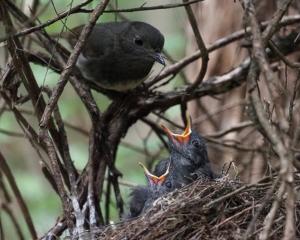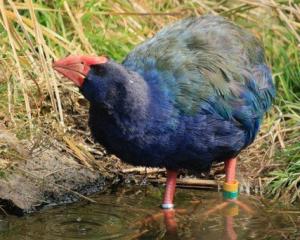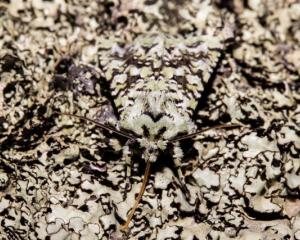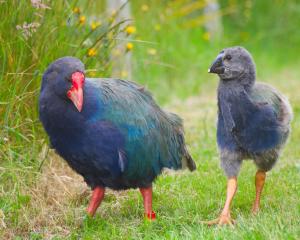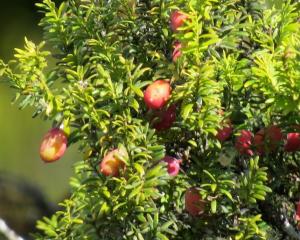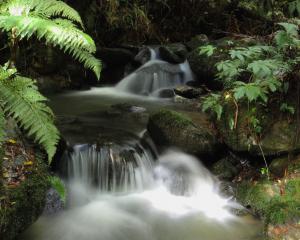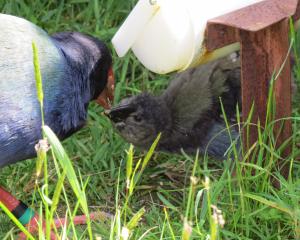People cutting down trees, people planting trees, all in the name of conservation. Matt Thomson and Alyth Grant report on work happening in Orokonui Ecosanctuary.
In recent weeks, Matt Thomson, a ranger at Orokonui Ecosanctuary, has been out felling trees with trainee arborists from Otago Polytechnic.
Meanwhile, at the upper end of the ecosanctuary, teams of volunteers have been using the winter months to plant trees in remaining open areas.
How are these two activities compatible?
Many visitors to Orokonui do not realise that the 307 hectares are not only in native bush. Near the bottom of the sanctuary is an extensive stand of eucalypts (Eucalyptus regnans), one of which is New Zealand's tallest tree.
They are all the offspring of a single tree whose seeds sprang up after a 1907 fire that destroyed an area of tea tree scrub.
And across the valley, on the eastern side, are 60ha of conifer forest (Pinus radiata), generously donated by Orokonui's neighbours, farmers Graeme and Marie Bennett; and then there are the 18ha of former dairy-farm land at the upper end of the sanctuary, where volunteers continue to remove gorse and other weeds in order to plant young natives and thus extend the area that can become home to more of our threatened species.
Does it matter that not all is in native forest? Is that why trees are being felled?
''No'' is the simple answer to both questions, though not the complete answer. Birds don't distinguish between native and exotic trees, they look for food of the kind they need: nectar for birds like tui, bellbird and silvereye; insects for the fantails, hunting on the wing; invertebrates for rifleman, brown creeper, grey warbler, tomtit and robin. In fact, many birds have quite a varied diet.
So what does our mixed forest provide? Eucalypts flower profusely, providing nourishment for the nectar-feeders, not to mention the Australian eastern rosellas! And naturally enough our robins, newly translocated from the city's pine plantations, settled where pines predominated. Only now that their numbers are increasing so rapidly are we meeting them in the native forest as well.
Kaka are often to be found in the macrocarpa that still stand on the former farmland. They love tearing off the bark to get into the sap of the soft wood underneath. As for kiwi, our volunteer planters were not at all surprised to learn that a number of them had made the trust land with all its remnant gorse and scrub their home, as wherever you dig a hole to plant a tree you find extremely large worms, a true delicacy from a kiwi point of view.
However, two other management factors combine rather well in the recent tree-felling activities. The Ecosanctuary has a fence to maintain and protect, and an education role.
One way to combine both is to give trainee arborists from Otago Polytechnic the chance to fell trees that potentially might fall on the fence. The ecosanctuary also has a mandate from the governing Otago Natural History Trust to remove all exotic vegetation within the 8.7km long fence.
While this may long remain an aspiration rather than a practical proposition, it is nice to think we can work towards providing for our native animals a successional plant community that will climax eventually with a podocarp-dominant canopy, as opposed to an exotic conifer and/or eucalypt canopy.
The composition of such a forest would approximate pre-human times in terms of its total species (flora and fauna).
Within the small marginal strip now clear-felled by the arborist students, an understorey of coprosma, wineberry, pittosporum, mahoe and broadleaf have suddenly and rudely found themselves as the pioneer community. This situation replicates a major disturbance such as a landslip or wind event in a natural forest, and will mean that before long we will have a native-dominant successional forest in this area, more resilient to weed infestation within 5-10 years, now that the pines do not have an advantage.
Straight felling is not a desirable technique, however, for the removal of more sparsely located or smaller stemmed trees within the sanctuary. We have been trying various forms of a technique called basal-bark treatment.
A technique pioneered by both Jamie Cowan of DoC Queenstown and Pete Raal of DoC Dunedin partly as a way to cost-effectively control wilding pines from the air, it was subsequently found the product used could be applied in a band around the lower trunk of a tree up to approximately 20cm in diameter, killing it without the need for any additional tools or methods.
Now a ready-made version of this product, called ''X-tree basal'', has been developed which remains on the stem without run-off. Effectively a ''chemical ring-barking'', it is an advantageous tool in the discrete control of trees in a place like Orokonui.
By killing a tree while it is standing, the light-well that encourages weed reinvasion is minimised, the understorey remains undamaged and birds can still safely nest and use the trees for perching until they break down naturally. It is also far safer and cheaper than chainsaw use.
Once the leaves or needles drop off, the additional light available should encourage the growth of native species to fill the gap. This way we will gradually alter the successional process with minimal disturbance to plant and animal life. Gains all round!
- Matt Thomson is a ranger and volunteer coordinator at Orokonui Ecosanctuary with a background in botany and pest control, and was previously wilding pine control coordinator for Forest & Bird. Alyth Grant volunteers as a planter.


